Greenburger HRMIC Assignment: US Market Expansion and IHRM Strategies
VerifiedAdded on 2020/04/21
|21
|4977
|62
Report
AI Summary
This report analyzes the international human resource management (IHRM) challenges faced by Greenburger, a Chinese fast-food chain, as it expands into the United States. It examines cultural differences between China and the US using Hofstede's 6D model and Trompenaar's 7D model, highlighting their impact on recruitment, selection, and staffing. The report critically discusses the concepts and theories used, and applies them to the impact of IHRM. It explores the implications of these cultural differences, such as power distance, individualism, masculinity, uncertainty avoidance, long-term orientation, and indulgence, and how they affect workplace behavior and employee expectations. The report further analyzes different international expansion strategies, specifically the Ethnocentric, Polycentric, Regiocentric, and Geocentric models, and recommends solutions to address the identified challenges, considering factors like biases, workplace behavior, success orientation, flexibility, laws, and work-life balance. Ultimately, the report provides recommendations to help Greenburger navigate the cultural nuances of the US market and ensure successful international expansion.
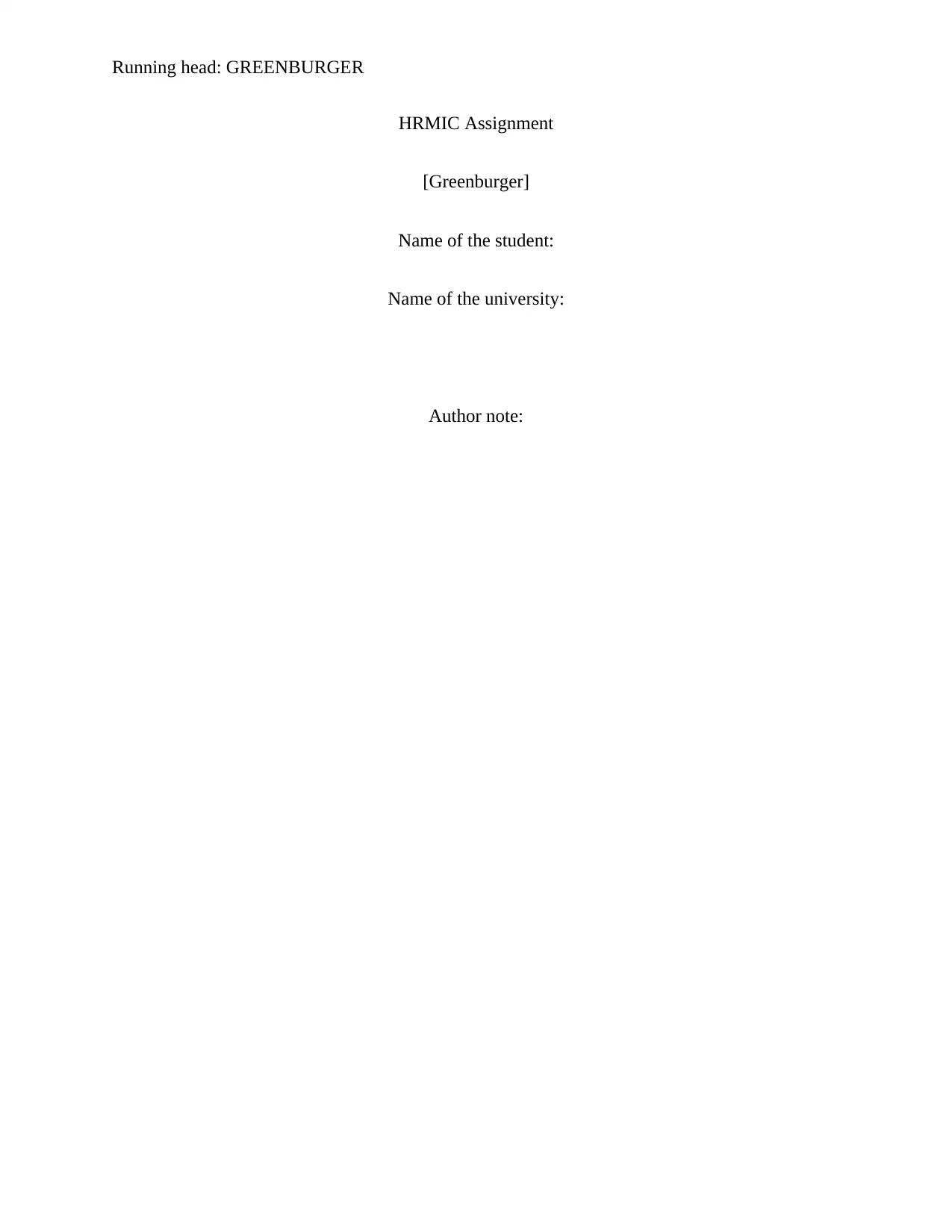
Running head: GREENBURGER
HRMIC Assignment
[Greenburger]
Name of the student:
Name of the university:
Author note:
HRMIC Assignment
[Greenburger]
Name of the student:
Name of the university:
Author note:
Paraphrase This Document
Need a fresh take? Get an instant paraphrase of this document with our AI Paraphraser

1GREENBURGER
Executive summary
This paper has covered an important discussion on the cultural differences and its impact on
foreign business. Greenburger is a Chinese fast-food restaurant chain. The success in the home
country China has encouraged the company for the United States. The paper shows the expected
challenges and the opportunities, which is there in the target market. The paper has also
recommended some solutions against the identified challenges. However, the recommended
solutions might also not work. It entirely depends on how the company implements the
suggested strategies or the few others if it is possible.
Executive summary
This paper has covered an important discussion on the cultural differences and its impact on
foreign business. Greenburger is a Chinese fast-food restaurant chain. The success in the home
country China has encouraged the company for the United States. The paper shows the expected
challenges and the opportunities, which is there in the target market. The paper has also
recommended some solutions against the identified challenges. However, the recommended
solutions might also not work. It entirely depends on how the company implements the
suggested strategies or the few others if it is possible.

2GREENBURGER
Table of Contents
1. Introduction..................................................................................................................................3
2. Discussion....................................................................................................................................3
2.1 Question 1..............................................................................................................................3
a) Critically discuss the concepts and theories used................................................................3
b) Application of theories to the impact of IHRM..................................................................8
2.2. Question 2.............................................................................................................................9
a) Critically discuss the concepts and theories used................................................................9
b) Application of theories to the staffing chosen...................................................................13
2.3. Question 3...........................................................................................................................13
a) Critically discuss the concepts and theories used..............................................................13
b) Application of the theories to the recruitment, selection, and others of IHRM................14
3. Conclusion.................................................................................................................................15
4. Recommendations......................................................................................................................15
References......................................................................................................................................18
Table of Contents
1. Introduction..................................................................................................................................3
2. Discussion....................................................................................................................................3
2.1 Question 1..............................................................................................................................3
a) Critically discuss the concepts and theories used................................................................3
b) Application of theories to the impact of IHRM..................................................................8
2.2. Question 2.............................................................................................................................9
a) Critically discuss the concepts and theories used................................................................9
b) Application of theories to the staffing chosen...................................................................13
2.3. Question 3...........................................................................................................................13
a) Critically discuss the concepts and theories used..............................................................13
b) Application of the theories to the recruitment, selection, and others of IHRM................14
3. Conclusion.................................................................................................................................15
4. Recommendations......................................................................................................................15
References......................................................................................................................................18
⊘ This is a preview!⊘
Do you want full access?
Subscribe today to unlock all pages.

Trusted by 1+ million students worldwide

3GREENBURGER
1. Introduction
Globalization has enhanced the area of responsibility for the international human
resource management in relation to the challenges it contends. Human and cultural problems are
the commonest challenges. International markets are full of opportunities for the multinational
companies as well. In such situations, this is really advisable to follow the footsteps of successful
multinational companies at the global platform (Story, Barbuto, Luthans & Bovaird 2014, p.
131-155). On the other hand, the current study suggests some other points to consider while
expanding to an international market. This provides some theoretical and conceptual background
to guide the expansion of a Chinese company Greenburger in the United States. It recommends
the use of theories as such of Hofstede 6D model & Trompenaar 7D model to better understand
the culture of the target market.
2. Discussion
2.1 Question 1
a) Critically discuss the concepts and theories used
1. Introduction
Globalization has enhanced the area of responsibility for the international human
resource management in relation to the challenges it contends. Human and cultural problems are
the commonest challenges. International markets are full of opportunities for the multinational
companies as well. In such situations, this is really advisable to follow the footsteps of successful
multinational companies at the global platform (Story, Barbuto, Luthans & Bovaird 2014, p.
131-155). On the other hand, the current study suggests some other points to consider while
expanding to an international market. This provides some theoretical and conceptual background
to guide the expansion of a Chinese company Greenburger in the United States. It recommends
the use of theories as such of Hofstede 6D model & Trompenaar 7D model to better understand
the culture of the target market.
2. Discussion
2.1 Question 1
a) Critically discuss the concepts and theories used
Paraphrase This Document
Need a fresh take? Get an instant paraphrase of this document with our AI Paraphraser
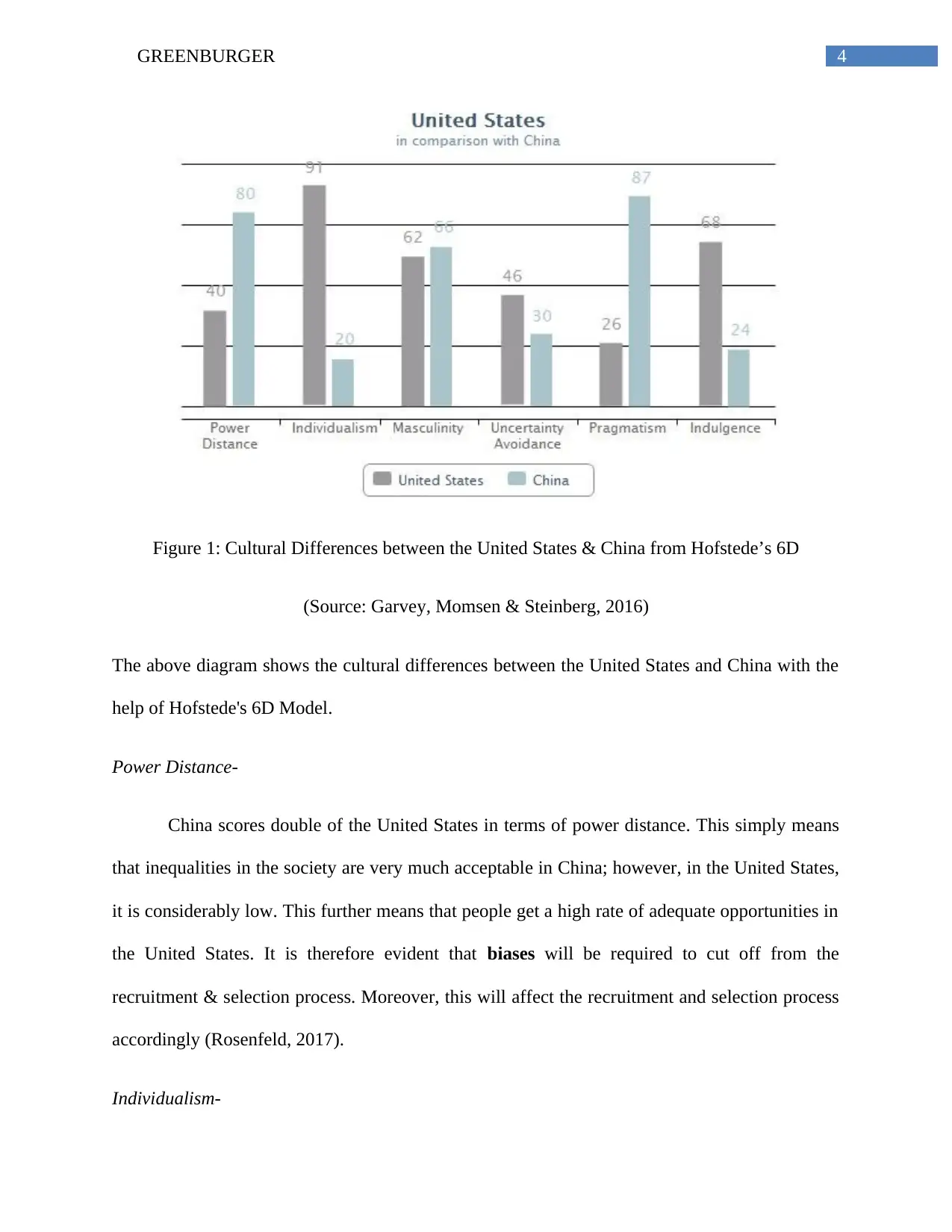
4GREENBURGER
Figure 1: Cultural Differences between the United States & China from Hofstede’s 6D
(Source: Garvey, Momsen & Steinberg, 2016)
The above diagram shows the cultural differences between the United States and China with the
help of Hofstede's 6D Model.
Power Distance-
China scores double of the United States in terms of power distance. This simply means
that inequalities in the society are very much acceptable in China; however, in the United States,
it is considerably low. This further means that people get a high rate of adequate opportunities in
the United States. It is therefore evident that biases will be required to cut off from the
recruitment & selection process. Moreover, this will affect the recruitment and selection process
accordingly (Rosenfeld, 2017).
Individualism-
Figure 1: Cultural Differences between the United States & China from Hofstede’s 6D
(Source: Garvey, Momsen & Steinberg, 2016)
The above diagram shows the cultural differences between the United States and China with the
help of Hofstede's 6D Model.
Power Distance-
China scores double of the United States in terms of power distance. This simply means
that inequalities in the society are very much acceptable in China; however, in the United States,
it is considerably low. This further means that people get a high rate of adequate opportunities in
the United States. It is therefore evident that biases will be required to cut off from the
recruitment & selection process. Moreover, this will affect the recruitment and selection process
accordingly (Rosenfeld, 2017).
Individualism-
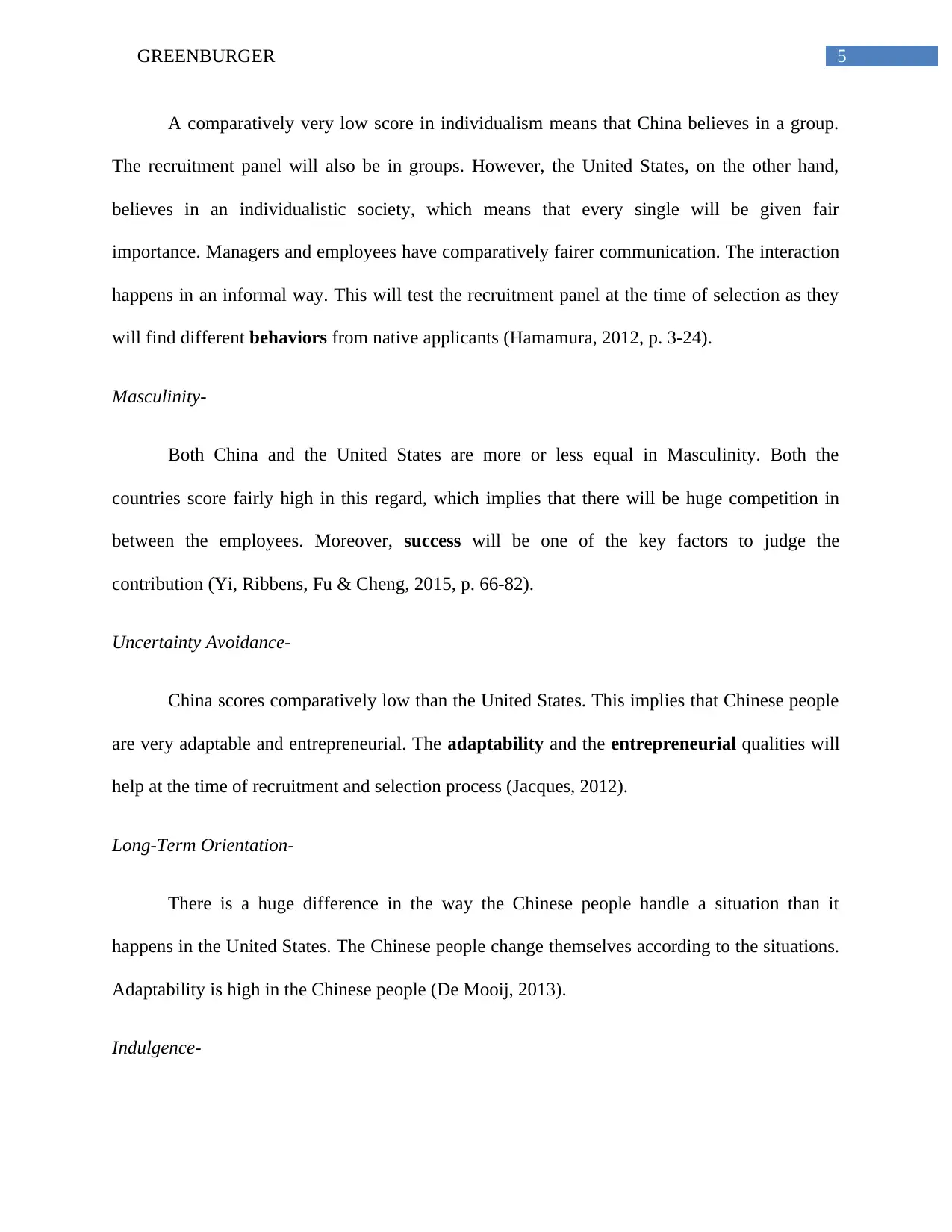
5GREENBURGER
A comparatively very low score in individualism means that China believes in a group.
The recruitment panel will also be in groups. However, the United States, on the other hand,
believes in an individualistic society, which means that every single will be given fair
importance. Managers and employees have comparatively fairer communication. The interaction
happens in an informal way. This will test the recruitment panel at the time of selection as they
will find different behaviors from native applicants (Hamamura, 2012, p. 3-24).
Masculinity-
Both China and the United States are more or less equal in Masculinity. Both the
countries score fairly high in this regard, which implies that there will be huge competition in
between the employees. Moreover, success will be one of the key factors to judge the
contribution (Yi, Ribbens, Fu & Cheng, 2015, p. 66-82).
Uncertainty Avoidance-
China scores comparatively low than the United States. This implies that Chinese people
are very adaptable and entrepreneurial. The adaptability and the entrepreneurial qualities will
help at the time of recruitment and selection process (Jacques, 2012).
Long-Term Orientation-
There is a huge difference in the way the Chinese people handle a situation than it
happens in the United States. The Chinese people change themselves according to the situations.
Adaptability is high in the Chinese people (De Mooij, 2013).
Indulgence-
A comparatively very low score in individualism means that China believes in a group.
The recruitment panel will also be in groups. However, the United States, on the other hand,
believes in an individualistic society, which means that every single will be given fair
importance. Managers and employees have comparatively fairer communication. The interaction
happens in an informal way. This will test the recruitment panel at the time of selection as they
will find different behaviors from native applicants (Hamamura, 2012, p. 3-24).
Masculinity-
Both China and the United States are more or less equal in Masculinity. Both the
countries score fairly high in this regard, which implies that there will be huge competition in
between the employees. Moreover, success will be one of the key factors to judge the
contribution (Yi, Ribbens, Fu & Cheng, 2015, p. 66-82).
Uncertainty Avoidance-
China scores comparatively low than the United States. This implies that Chinese people
are very adaptable and entrepreneurial. The adaptability and the entrepreneurial qualities will
help at the time of recruitment and selection process (Jacques, 2012).
Long-Term Orientation-
There is a huge difference in the way the Chinese people handle a situation than it
happens in the United States. The Chinese people change themselves according to the situations.
Adaptability is high in the Chinese people (De Mooij, 2013).
Indulgence-
⊘ This is a preview!⊘
Do you want full access?
Subscribe today to unlock all pages.

Trusted by 1+ million students worldwide
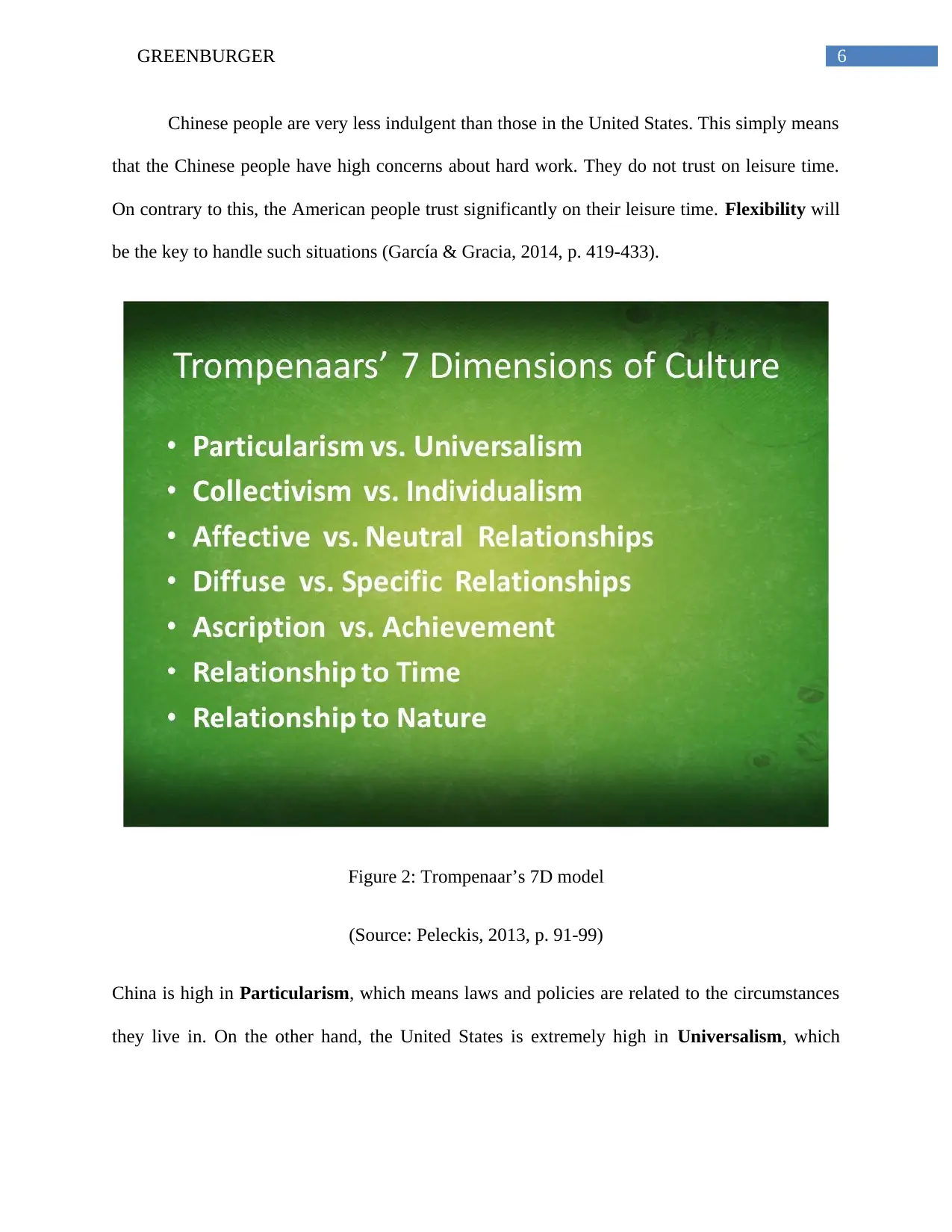
6GREENBURGER
Chinese people are very less indulgent than those in the United States. This simply means
that the Chinese people have high concerns about hard work. They do not trust on leisure time.
On contrary to this, the American people trust significantly on their leisure time. Flexibility will
be the key to handle such situations (García & Gracia, 2014, p. 419-433).
Figure 2: Trompenaar’s 7D model
(Source: Peleckis, 2013, p. 91-99)
China is high in Particularism, which means laws and policies are related to the circumstances
they live in. On the other hand, the United States is extremely high in Universalism, which
Chinese people are very less indulgent than those in the United States. This simply means
that the Chinese people have high concerns about hard work. They do not trust on leisure time.
On contrary to this, the American people trust significantly on their leisure time. Flexibility will
be the key to handle such situations (García & Gracia, 2014, p. 419-433).
Figure 2: Trompenaar’s 7D model
(Source: Peleckis, 2013, p. 91-99)
China is high in Particularism, which means laws and policies are related to the circumstances
they live in. On the other hand, the United States is extremely high in Universalism, which
Paraphrase This Document
Need a fresh take? Get an instant paraphrase of this document with our AI Paraphraser
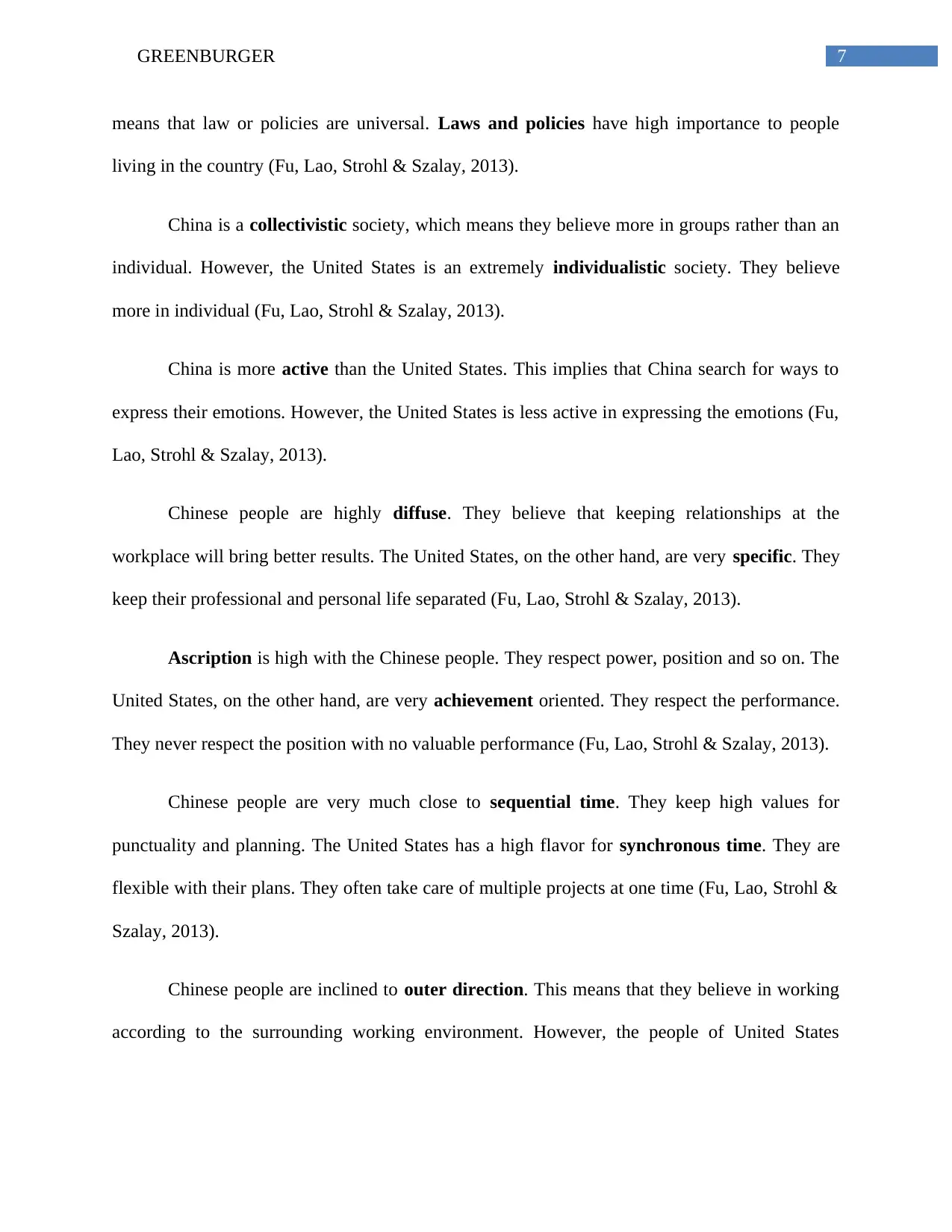
7GREENBURGER
means that law or policies are universal. Laws and policies have high importance to people
living in the country (Fu, Lao, Strohl & Szalay, 2013).
China is a collectivistic society, which means they believe more in groups rather than an
individual. However, the United States is an extremely individualistic society. They believe
more in individual (Fu, Lao, Strohl & Szalay, 2013).
China is more active than the United States. This implies that China search for ways to
express their emotions. However, the United States is less active in expressing the emotions (Fu,
Lao, Strohl & Szalay, 2013).
Chinese people are highly diffuse. They believe that keeping relationships at the
workplace will bring better results. The United States, on the other hand, are very specific. They
keep their professional and personal life separated (Fu, Lao, Strohl & Szalay, 2013).
Ascription is high with the Chinese people. They respect power, position and so on. The
United States, on the other hand, are very achievement oriented. They respect the performance.
They never respect the position with no valuable performance (Fu, Lao, Strohl & Szalay, 2013).
Chinese people are very much close to sequential time. They keep high values for
punctuality and planning. The United States has a high flavor for synchronous time. They are
flexible with their plans. They often take care of multiple projects at one time (Fu, Lao, Strohl &
Szalay, 2013).
Chinese people are inclined to outer direction. This means that they believe in working
according to the surrounding working environment. However, the people of United States
means that law or policies are universal. Laws and policies have high importance to people
living in the country (Fu, Lao, Strohl & Szalay, 2013).
China is a collectivistic society, which means they believe more in groups rather than an
individual. However, the United States is an extremely individualistic society. They believe
more in individual (Fu, Lao, Strohl & Szalay, 2013).
China is more active than the United States. This implies that China search for ways to
express their emotions. However, the United States is less active in expressing the emotions (Fu,
Lao, Strohl & Szalay, 2013).
Chinese people are highly diffuse. They believe that keeping relationships at the
workplace will bring better results. The United States, on the other hand, are very specific. They
keep their professional and personal life separated (Fu, Lao, Strohl & Szalay, 2013).
Ascription is high with the Chinese people. They respect power, position and so on. The
United States, on the other hand, are very achievement oriented. They respect the performance.
They never respect the position with no valuable performance (Fu, Lao, Strohl & Szalay, 2013).
Chinese people are very much close to sequential time. They keep high values for
punctuality and planning. The United States has a high flavor for synchronous time. They are
flexible with their plans. They often take care of multiple projects at one time (Fu, Lao, Strohl &
Szalay, 2013).
Chinese people are inclined to outer direction. This means that they believe in working
according to the surrounding working environment. However, the people of United States
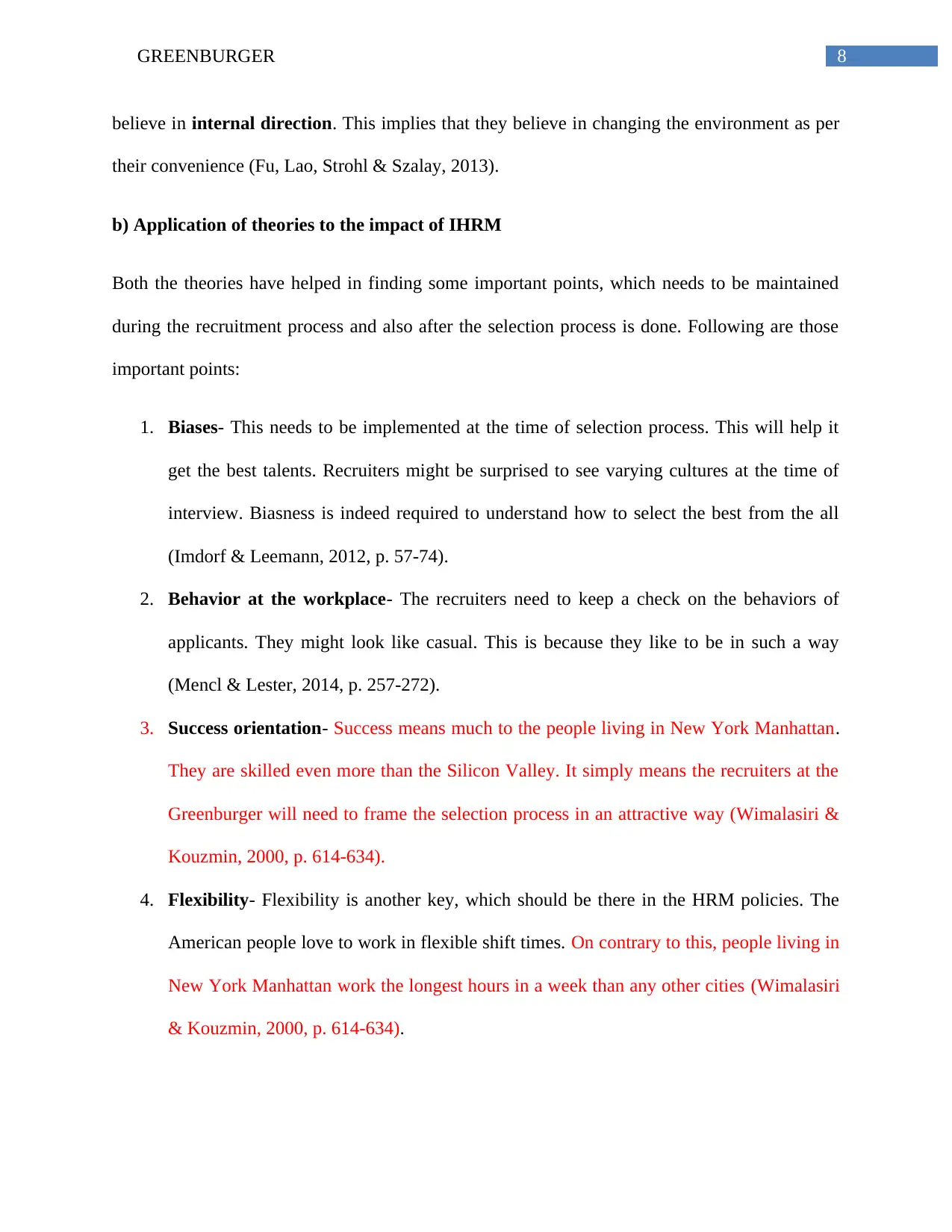
8GREENBURGER
believe in internal direction. This implies that they believe in changing the environment as per
their convenience (Fu, Lao, Strohl & Szalay, 2013).
b) Application of theories to the impact of IHRM
Both the theories have helped in finding some important points, which needs to be maintained
during the recruitment process and also after the selection process is done. Following are those
important points:
1. Biases- This needs to be implemented at the time of selection process. This will help it
get the best talents. Recruiters might be surprised to see varying cultures at the time of
interview. Biasness is indeed required to understand how to select the best from the all
(Imdorf & Leemann, 2012, p. 57-74).
2. Behavior at the workplace- The recruiters need to keep a check on the behaviors of
applicants. They might look like casual. This is because they like to be in such a way
(Mencl & Lester, 2014, p. 257-272).
3. Success orientation- Success means much to the people living in New York Manhattan.
They are skilled even more than the Silicon Valley. It simply means the recruiters at the
Greenburger will need to frame the selection process in an attractive way (Wimalasiri &
Kouzmin, 2000, p. 614-634).
4. Flexibility- Flexibility is another key, which should be there in the HRM policies. The
American people love to work in flexible shift times. On contrary to this, people living in
New York Manhattan work the longest hours in a week than any other cities (Wimalasiri
& Kouzmin, 2000, p. 614-634).
believe in internal direction. This implies that they believe in changing the environment as per
their convenience (Fu, Lao, Strohl & Szalay, 2013).
b) Application of theories to the impact of IHRM
Both the theories have helped in finding some important points, which needs to be maintained
during the recruitment process and also after the selection process is done. Following are those
important points:
1. Biases- This needs to be implemented at the time of selection process. This will help it
get the best talents. Recruiters might be surprised to see varying cultures at the time of
interview. Biasness is indeed required to understand how to select the best from the all
(Imdorf & Leemann, 2012, p. 57-74).
2. Behavior at the workplace- The recruiters need to keep a check on the behaviors of
applicants. They might look like casual. This is because they like to be in such a way
(Mencl & Lester, 2014, p. 257-272).
3. Success orientation- Success means much to the people living in New York Manhattan.
They are skilled even more than the Silicon Valley. It simply means the recruiters at the
Greenburger will need to frame the selection process in an attractive way (Wimalasiri &
Kouzmin, 2000, p. 614-634).
4. Flexibility- Flexibility is another key, which should be there in the HRM policies. The
American people love to work in flexible shift times. On contrary to this, people living in
New York Manhattan work the longest hours in a week than any other cities (Wimalasiri
& Kouzmin, 2000, p. 614-634).
⊘ This is a preview!⊘
Do you want full access?
Subscribe today to unlock all pages.

Trusted by 1+ million students worldwide

9GREENBURGER
5. Laws & policies- Universalism is prevalent in the United States, which means that the
HRM need to design the policies in such a way that it is applicable to all the employees
irrespective of their country of origin (Culpepper & Reinke, 2014, p. 427-454).
6. Neutral workplace- The workplace environment needs to be neutral in order to let the
American people feel like their home country. They have less attachment to the emotions
(Mencl & Lester, 2014, p. 257-272).
7. Work-life balance- This is another point, which is differing in nature than China. People
in America prefer working according to their thoughts. There should not be hard & strict
rules imposed on them or else they will look for some other opportunities. However,
Greenburger might find them blessed as they have chosen New York Manhattan, which is
way different to other cities in America. People living in New York work for longer
hours in a week (Mencl & Lester, 2014, p. 257-272).
2.2. Question 2
a) Critically discuss the concepts and theories used
According to the Perlmutter & Heenan’s ERPG model, there are four ways in which
business and their members need to think such as Ethnocentric, Polycentric, Regiocentric, and
Geocentric (Wach & Wojciechowski, 2014, p. 143-156). Geocentric is the most commonly used
strategies in most of the international expansion cases. Following is the analysis of all the
strategies postulated by Perlmutter & Heenan’s:
Ethnocentric-
These are such companies who feel that the home country does provide a superior market
to those. They rarely look for the international market. If they have to expand to the international
5. Laws & policies- Universalism is prevalent in the United States, which means that the
HRM need to design the policies in such a way that it is applicable to all the employees
irrespective of their country of origin (Culpepper & Reinke, 2014, p. 427-454).
6. Neutral workplace- The workplace environment needs to be neutral in order to let the
American people feel like their home country. They have less attachment to the emotions
(Mencl & Lester, 2014, p. 257-272).
7. Work-life balance- This is another point, which is differing in nature than China. People
in America prefer working according to their thoughts. There should not be hard & strict
rules imposed on them or else they will look for some other opportunities. However,
Greenburger might find them blessed as they have chosen New York Manhattan, which is
way different to other cities in America. People living in New York work for longer
hours in a week (Mencl & Lester, 2014, p. 257-272).
2.2. Question 2
a) Critically discuss the concepts and theories used
According to the Perlmutter & Heenan’s ERPG model, there are four ways in which
business and their members need to think such as Ethnocentric, Polycentric, Regiocentric, and
Geocentric (Wach & Wojciechowski, 2014, p. 143-156). Geocentric is the most commonly used
strategies in most of the international expansion cases. Following is the analysis of all the
strategies postulated by Perlmutter & Heenan’s:
Ethnocentric-
These are such companies who feel that the home country does provide a superior market
to those. They rarely look for the international market. If they have to expand to the international
Paraphrase This Document
Need a fresh take? Get an instant paraphrase of this document with our AI Paraphraser
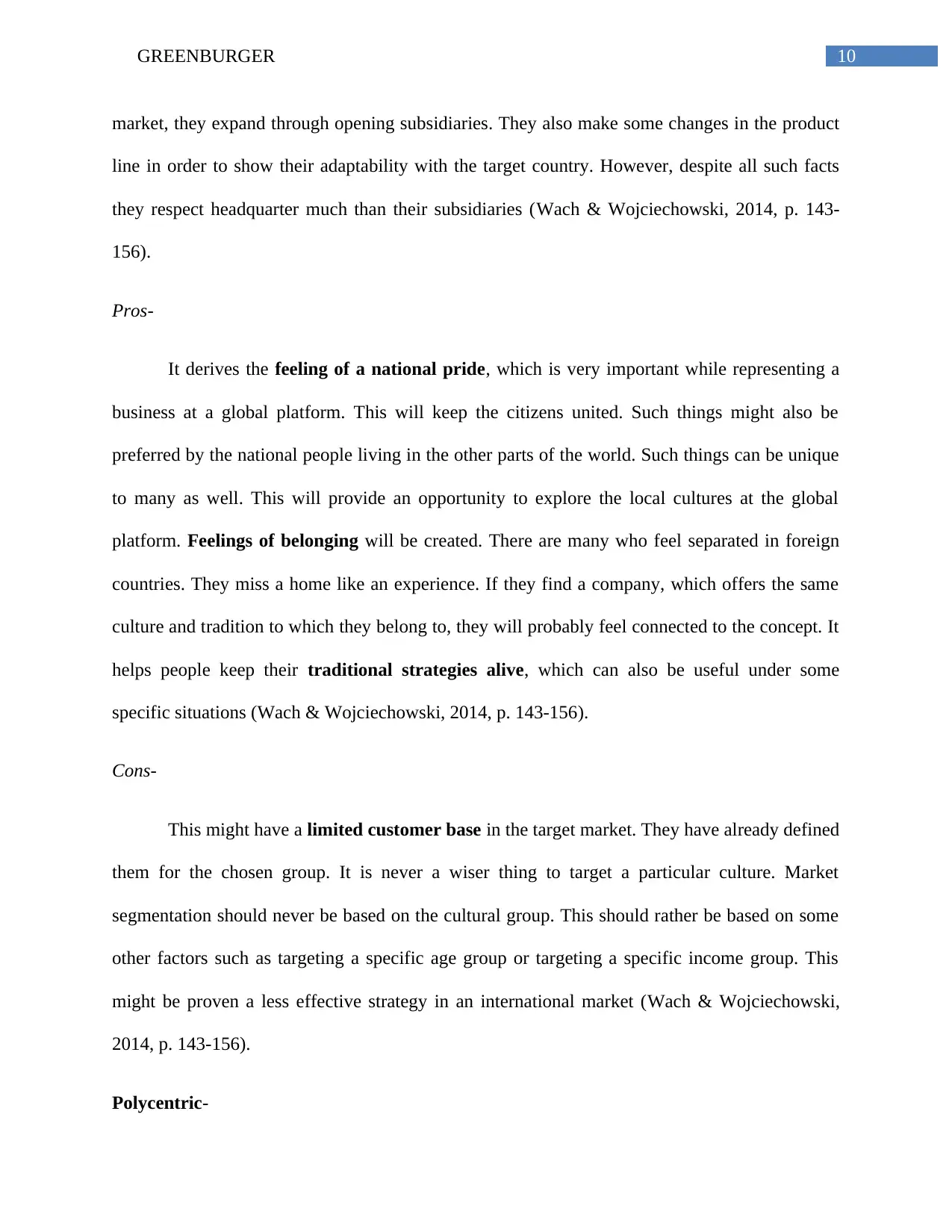
10GREENBURGER
market, they expand through opening subsidiaries. They also make some changes in the product
line in order to show their adaptability with the target country. However, despite all such facts
they respect headquarter much than their subsidiaries (Wach & Wojciechowski, 2014, p. 143-
156).
Pros-
It derives the feeling of a national pride, which is very important while representing a
business at a global platform. This will keep the citizens united. Such things might also be
preferred by the national people living in the other parts of the world. Such things can be unique
to many as well. This will provide an opportunity to explore the local cultures at the global
platform. Feelings of belonging will be created. There are many who feel separated in foreign
countries. They miss a home like an experience. If they find a company, which offers the same
culture and tradition to which they belong to, they will probably feel connected to the concept. It
helps people keep their traditional strategies alive, which can also be useful under some
specific situations (Wach & Wojciechowski, 2014, p. 143-156).
Cons-
This might have a limited customer base in the target market. They have already defined
them for the chosen group. It is never a wiser thing to target a particular culture. Market
segmentation should never be based on the cultural group. This should rather be based on some
other factors such as targeting a specific age group or targeting a specific income group. This
might be proven a less effective strategy in an international market (Wach & Wojciechowski,
2014, p. 143-156).
Polycentric-
market, they expand through opening subsidiaries. They also make some changes in the product
line in order to show their adaptability with the target country. However, despite all such facts
they respect headquarter much than their subsidiaries (Wach & Wojciechowski, 2014, p. 143-
156).
Pros-
It derives the feeling of a national pride, which is very important while representing a
business at a global platform. This will keep the citizens united. Such things might also be
preferred by the national people living in the other parts of the world. Such things can be unique
to many as well. This will provide an opportunity to explore the local cultures at the global
platform. Feelings of belonging will be created. There are many who feel separated in foreign
countries. They miss a home like an experience. If they find a company, which offers the same
culture and tradition to which they belong to, they will probably feel connected to the concept. It
helps people keep their traditional strategies alive, which can also be useful under some
specific situations (Wach & Wojciechowski, 2014, p. 143-156).
Cons-
This might have a limited customer base in the target market. They have already defined
them for the chosen group. It is never a wiser thing to target a particular culture. Market
segmentation should never be based on the cultural group. This should rather be based on some
other factors such as targeting a specific age group or targeting a specific income group. This
might be proven a less effective strategy in an international market (Wach & Wojciechowski,
2014, p. 143-156).
Polycentric-
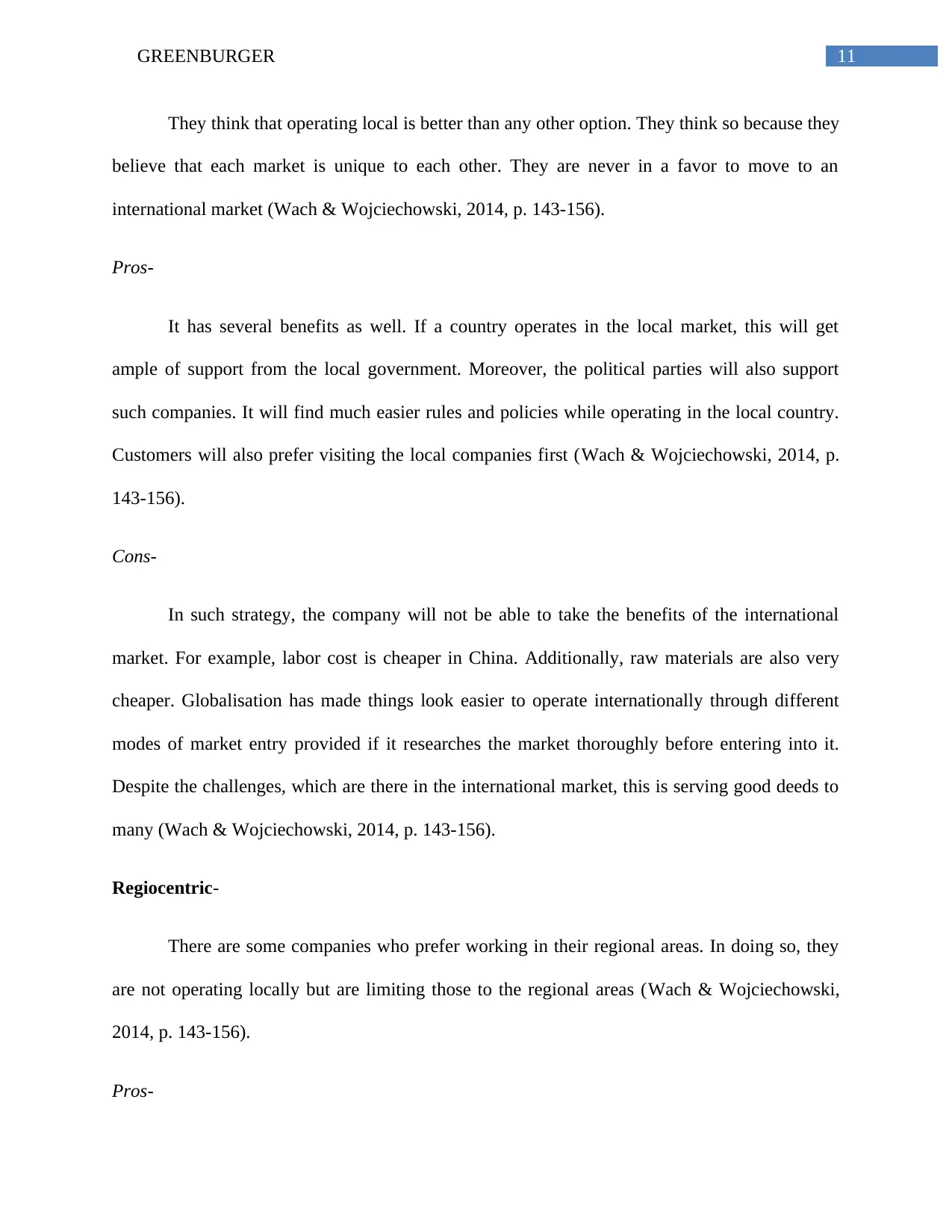
11GREENBURGER
They think that operating local is better than any other option. They think so because they
believe that each market is unique to each other. They are never in a favor to move to an
international market (Wach & Wojciechowski, 2014, p. 143-156).
Pros-
It has several benefits as well. If a country operates in the local market, this will get
ample of support from the local government. Moreover, the political parties will also support
such companies. It will find much easier rules and policies while operating in the local country.
Customers will also prefer visiting the local companies first (Wach & Wojciechowski, 2014, p.
143-156).
Cons-
In such strategy, the company will not be able to take the benefits of the international
market. For example, labor cost is cheaper in China. Additionally, raw materials are also very
cheaper. Globalisation has made things look easier to operate internationally through different
modes of market entry provided if it researches the market thoroughly before entering into it.
Despite the challenges, which are there in the international market, this is serving good deeds to
many (Wach & Wojciechowski, 2014, p. 143-156).
Regiocentric-
There are some companies who prefer working in their regional areas. In doing so, they
are not operating locally but are limiting those to the regional areas (Wach & Wojciechowski,
2014, p. 143-156).
Pros-
They think that operating local is better than any other option. They think so because they
believe that each market is unique to each other. They are never in a favor to move to an
international market (Wach & Wojciechowski, 2014, p. 143-156).
Pros-
It has several benefits as well. If a country operates in the local market, this will get
ample of support from the local government. Moreover, the political parties will also support
such companies. It will find much easier rules and policies while operating in the local country.
Customers will also prefer visiting the local companies first (Wach & Wojciechowski, 2014, p.
143-156).
Cons-
In such strategy, the company will not be able to take the benefits of the international
market. For example, labor cost is cheaper in China. Additionally, raw materials are also very
cheaper. Globalisation has made things look easier to operate internationally through different
modes of market entry provided if it researches the market thoroughly before entering into it.
Despite the challenges, which are there in the international market, this is serving good deeds to
many (Wach & Wojciechowski, 2014, p. 143-156).
Regiocentric-
There are some companies who prefer working in their regional areas. In doing so, they
are not operating locally but are limiting those to the regional areas (Wach & Wojciechowski,
2014, p. 143-156).
Pros-
⊘ This is a preview!⊘
Do you want full access?
Subscribe today to unlock all pages.

Trusted by 1+ million students worldwide
1 out of 21
Related Documents
Your All-in-One AI-Powered Toolkit for Academic Success.
+13062052269
info@desklib.com
Available 24*7 on WhatsApp / Email
![[object Object]](/_next/static/media/star-bottom.7253800d.svg)
Unlock your academic potential
Copyright © 2020–2025 A2Z Services. All Rights Reserved. Developed and managed by ZUCOL.





